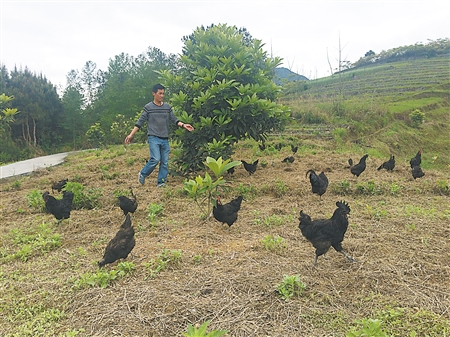Cherry delicious trees are difficult to plant for 5 years, and finally wait for the great yield of "Changzhou cherry".
Cherry delicious trees are hard to plant, as are Chinese cherries and American big cherries. Located in Xinqiao Town, New North District, Changzhou Hongda vegetable Professional Cooperative has a Qiu Jianguo who likes to grow melons and fruits that no one else has. The American big cherry planted by Lao Qiu can weigh up to 8 grams per seed, which is a veritable big cherry.
It took five years to finally get a good yield of big cherries.
In the eyes of professionals, the cherry tree is a bit demanding on the environment: at a temperature of 0-7 degrees, a cherry tree must reach a cold accumulated temperature of 1000 hours before it can blossom and bear fruit, so it can only be a product near a specific latitude.
The recognized place in China for growing big cherries is Shandong, which is about 35 degrees north latitude, at the same latitude as the United States and about three latitudes higher than Changzhou, south of the Yangtze River. If we want to make the geographical and climatic conditions of Changzhou more in line with the growth habits of cherry trees, we can imagine the energy and time taken. In the words of Qiu Jianguo, head of the cooperative, it took several years of effort to grow them.
The cherry trees native to China blossomed in February. However, in early April, when the reporter interviewed at the HTC vegetable professional cooperative, he saw that some of the cherry trees in the greenhouse had fallen flowers and fruit, bearing green fruit the size of a baby's finger, while others were in full bloom. the branches are clustered with white flowers, which are obviously much larger than the flowers of Chinese cherries.
According to Qiu Jianguo, these cherry trees were introduced from the School of Agricultural Biology of Shanghai Jiaotong University in 2012. Each greenhouse is interspersed with different varieties of cherry trees, including Brooks, Ruby, Na Weng, Meizao, and so on. No matter which variety, the flowers are much larger than the flowers of Chinese cherries. The variety with the largest flower and the longest pedicel is the red light.
Lao Qiu said that growing big cherries in the United States is a very risky thing. Cherry trees have to wait for at least three years before they gradually enter the high-yield period. Last year was the first year. There were a total of 20 mu of cherries in several greenhouses, with a total of more than 1,000 cherry trees. This year only began to enter the full fruit period.
After attending the class at Shanghai Jiaotong University, he moved the cherry tree home.
In the vegetable growing industry in Changzhou, Lao Qiu, who has grown vegetables for half his life, is a little famous. In the early years, he only planted some popular varieties common in Changzhou. The varieties were ordinary, and the benefits were mediocre. With the development of efficient facility agriculture in our city, Lao Qiu began to pour out some varieties of vegetables that were rare on the market at that time, such as fruit cucumbers, colored tomatoes, and previously rare varieties of fruits in Changzhou, such as netted melons, cantaloupes, melons, and melons, and registered the "New North Star" trademark to the cooperative.
Over the past few years, more and more people have grown colored tomatoes and fruit cucumbers in Changzhou, and Lao Qiu is thinking about changing some varieties that other people don't have. So, after a lecture at Shanghai Jiaotong University, he moved the cherry tree back to Changzhou.
For these dozens of acres of cherries, Lao Qiu and his wife were full of hope and spent a lot of thought and effort to wait on them carefully. In order to make the cherry trees bear better fruit, this year, in addition to the traditional artificial pollination and bee pollination, Lao Qiu specially bought several boxes of pollinated bumblebees at the price of 400 yuan per box. The bees are huge and efficient in pollination. The price is not low: there are 80 bees in a box, which costs 5 yuan per bee. The three-pronged approach worked, and the fruiting trees looked gratifying, and the cherries in the greenhouse were expected to ripen in mid-late May, when Qiu and his wife were waiting for everyone to pick at Xinqiao.
- Prev

College students give up their rice bowls in state-owned enterprises to start their own businesses and raise hairy crabs
College students give up their rice bowls in state-owned enterprises to start their own businesses and raise hairy crabs
- Next

If you don't like pumpkin, native chicken, loquat tree, you will be rich if you understand it.
If you don't like pumpkin, native chicken, loquat tree, you will be rich if you understand it.
Related
- A course of planting techniques and methods on how to grow carrots
- How to plant the latest tulips?
- Is it better to pick tea in the morning or in the afternoon? When is the best time for tea to be picked? what is the third or fifth tea?
- Launch Yuanxiao Happy combination Haocha + Tea Yuan healthy Taste
- Penghu Tourism "Fireworks 20 Parade with You"
- 2022 West Lake Happiness holds "Digital Revitalization Voucher" and draws iphone13 and laptop.
- Banqiao Fuzhou social houses are designed to change start-up combined with police elimination to create a safe and livable environment
- The convenient measure of "mechanical weeding" in Xinbei has been abused and the Agriculture Bureau has imposed heavy penalties on the illegal land consolidation.
- Changgeng University Joins Hands with Four Memory Factories to Rescue Memory Talent Shortage
- The list of Taiwan's top 100 MVP managers is listed by the Director-General of the Farmers' Association of Sanxia District.

